height Acura ZDX 2012 Owner's Manual
[x] Cancel search | Manufacturer: ACURA, Model Year: 2012, Model line: ZDX, Model: Acura ZDX 2012Pages: 645, PDF Size: 16.36 MB
Page 22 of 645
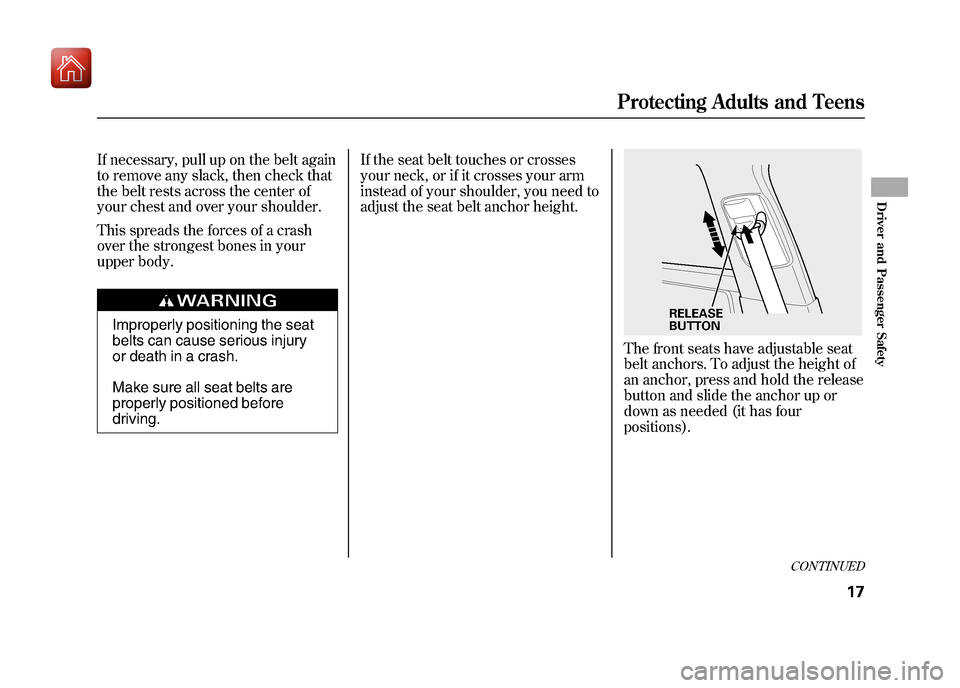
If necessary, pull up on the belt again
to remove any slack, then check that
the belt rests across the center of
your chest and over your shoulder.
This spreads the forces of a crash
over the strongest bones in your
upper body.
Improperly positioning the seat
belts can cause serious injury
or death in a crash.
Make sure all seat belts are
properly positioned before
driving.If the seat belt touches or crosses
your neck, or if it crosses your arm
instead of your shoulder, you need to
adjust the seat belt anchor height.
The front seats have adjustable seat
belt anchors. To adjust the height of
an anchor, press and hold the release
button and slide the anchor up or
down as needed (it has four
positions).
RELEASE
BUTTON
CONTINUED
Protecting Adults and Teens
17
Driver and Passenger Safety
09/10/28 17:15:37 10 ACURA ZDX KA KC New North America Own 50 31SZN600 enu
Page 49 of 645

Protecting InfantsChild Seat TypeAn infant must be properly restrained
in a rear-facing, reclining child seat
until the child reaches the seat
maker's weight or height limit for the
seat, and the child is at least one year
old.
Only a rear-facing child seat provides
proper support for a baby's head,
neck, and back.Two types of seats may be used: a
seat designed exclusively for infants,
or a convertible seat used in the rear-
facing, reclining mode.
Do not put a rear-facing child seat in
a forward-facing position.
If placed
facing forward, an infant could be
very seriously injured during a
frontal collision.
Rear-facing Child Seat PlacementA rear-facing child seat can be placed
in any seating position in the back
seat, but not in the front.
Never put a
rear-facing child seat in the front seat.
If the passenger's front airbag
inflates, it can hit the back of the
child seat with enough force to kill or
seriously injure an infant.
When properly installed, a rear-
facing child seat may prevent the
driver or a front passenger from
moving their seat as far back as
recommended, or from locking their
seat-back in the desired position.
It can also interfere with proper
operation of the passenger's
advanced front airbag system.
Protecting Infants and Small Children4409/10/28 17:15:37 10 ACURA ZDX KA KC New North America Own 50 31SZN600 enu
Page 50 of 645

In any of these situations, we
strongly recommend that you install
the child seat directly behind the
front passenger's seat, move the seat
as far forward as needed, and leave it
unoccupied. Or, you may wish to get
a smaller rear-facing child seat.
Placing a rear-facing child seat
in the front seat can result in
serious injury or death during a
crash.
Always place a rear-facing child
seat in the back seat, not the
front.Protecting Small Children
Child Seat TypeMany states, Canadian provinces and
territories allow a child one year of
age or older who also meets the
minimum size and weight
requirements to transition from a
rear-facing child seat to a forward
facing seat. Know the requirements
where you are driving and follow the
child seat instructions. Many experts
recommend use of a rear-facing seat
up to age two, if the child's height
and weight are appropriate for a rear-
facing seat.
Of the different seats available, we
recommend those that have a five-
point harness system as shown.
We also recommend that a small
child use the child seat until the child
reaches the weight or height limit for
the seat.
CONTINUED
Protecting Infants and Small Children
45
Driver and Passenger Safety
09/10/28 17:15:37 10 ACURA ZDX KA KC New North America Own 50 31SZN600 enu
Page 59 of 645
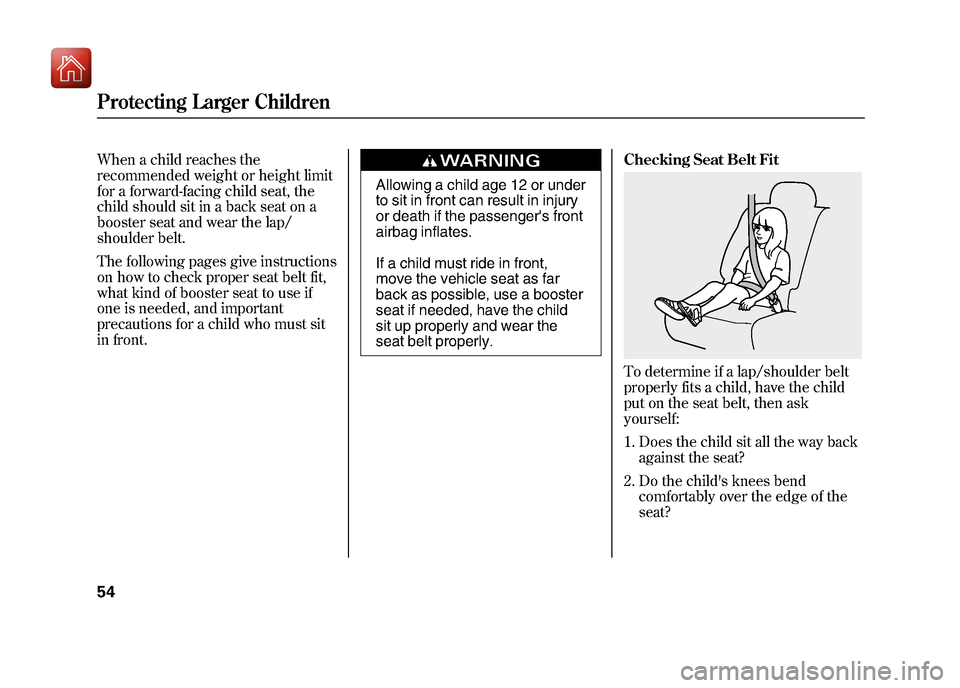
When a child reaches the
recommended weight or height limit
for a forward-facing child seat, the
child should sit in a back seat on a
booster seat and wear the lap/
shoulder belt.
The following pages give instructions
on how to check proper seat belt fit,
what kind of booster seat to use if
one is needed, and important
precautions for a child who must sit
in front.
Allowing a child age 12 or under
to sit in front can result in injury
or death if the passenger's front
airbag inflates.
If a child must ride in front,
move the vehicle seat as far
back as possible, use a booster
seat if needed, have the child
sit up properly and wear the
seat belt properly.Checking Seat Belt Fit
To determine if a lap/shoulder belt
properly fits a child, have the child
put on the seat belt, then ask
yourself:
1. Does the child sit all the way back
against the seat?
2. Do the child's knees bend comfortably over the edge of the
seat?
Protecting Larger Children5409/10/28 17:15:37 10 ACURA ZDX KA KC New North America Own 50 31SZN600 enu
Page 61 of 645
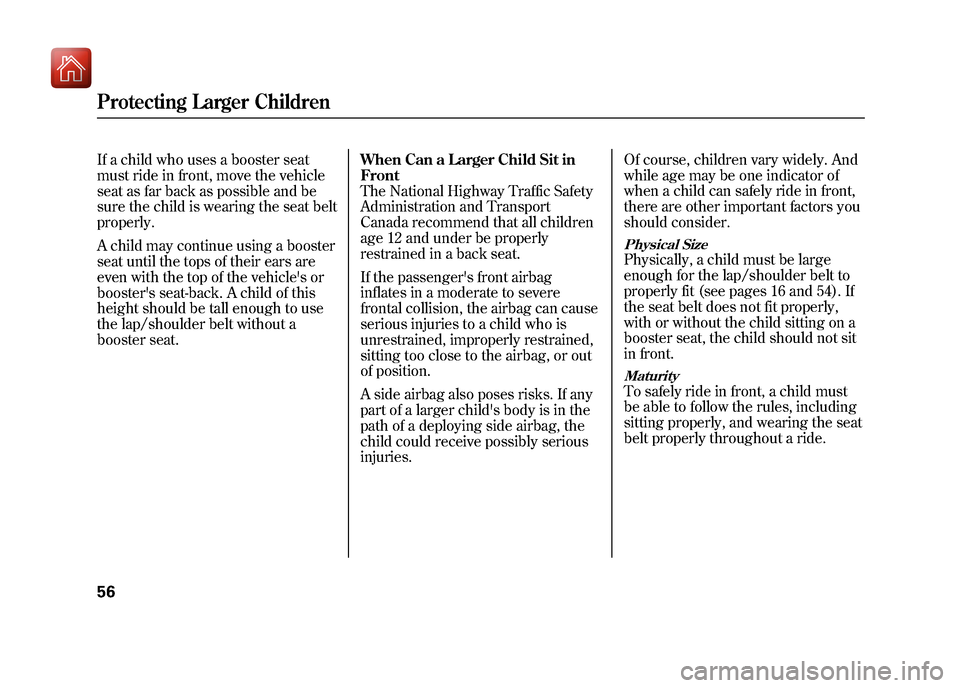
If a child who uses a booster seat
must ride in front, move the vehicle
seat as far back as possible and be
sure the child is wearing the seat belt
properly.
A child may continue using a booster
seat until the tops of their ears are
even with the top of the vehicle's or
booster's seat-back. A child of this
height should be tall enough to use
the lap/shoulder belt without a
booster seat.When Can a Larger Child Sit in
Front
The National Highway Traffic Safety
Administration and Transport
Canada recommend that all children
age 12 and under be properly
restrained in a back seat.
If the passenger's front airbag
inflates in a moderate to severe
frontal collision, the airbag can cause
serious injuries to a child who is
unrestrained, improperly restrained,
sitting too close to the airbag, or out
of position.
A side airbag also poses risks. If any
part of a larger child's body is in the
path of a deploying side airbag, the
child could receive possibly serious
injuries.Of course, children vary widely. And
while age may be one indicator of
when a child can safely ride in front,
there are other important factors you
should consider.
Physical SizePhysically, a child must be large
enough for the lap/shoulder belt to
properly fit (see pages 16 and 54). If
the seat belt does not fit properly,
with or without the child sitting on a
booster seat, the child should not sit
in front.MaturityTo safely ride in front, a child must
be able to follow the rules, including
sitting properly, and wearing the seat
belt properly throughout a ride.
Protecting Larger Children5609/10/28 17:15:37 10 ACURA ZDX KA KC New North America Own 50 31SZN600 enu
Page 168 of 645
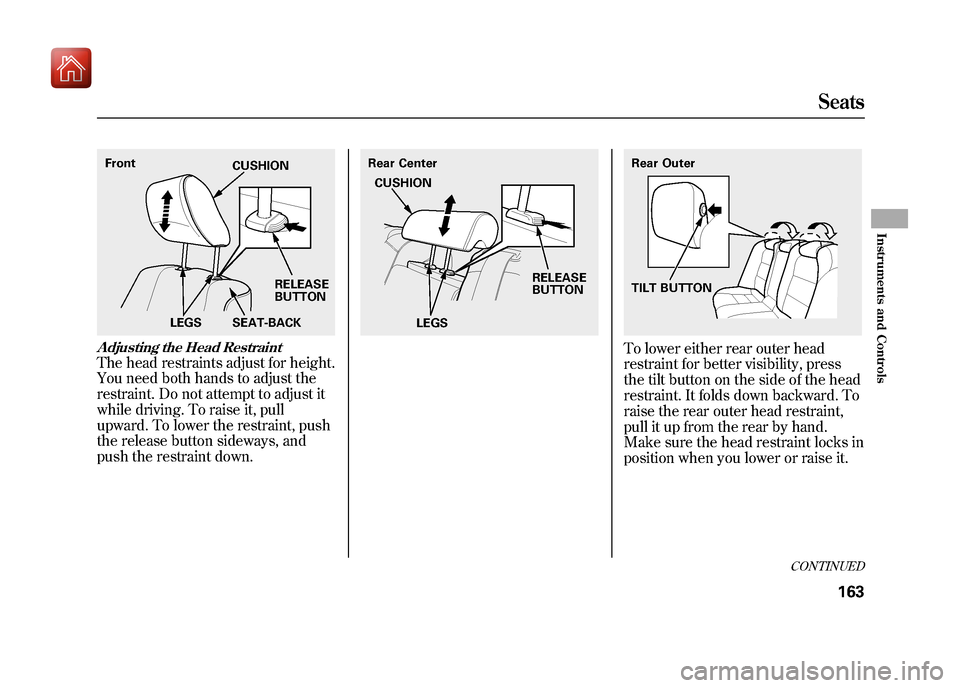
Adjusting the Head RestraintThe head restraints adjust for height.
You need both hands to adjust the
restraint. Do not attempt to adjust it
while driving. To raise it, pull
upward. To lower the restraint, push
the release button sideways, and
push the restraint down.
To lower either rear outer head
restraint for better visibility, press
the tilt button on the side of the head
restraint. It folds down backward. To
raise the rear outer head restraint,
pull it up from the rear by hand.
Make sure the head restraint locks in
position when you lower or raise it.
FrontSEAT-BACK
LEGS RELEASE
BUTTON
CUSHION
Rear Center
LEGS RELEASE
BUTTON
CUSHION
Rear Outer
TILT BUTTON
CONTINUED
Seats
163
Instruments and Controls
09/10/28 17:15:37 10 ACURA ZDX KA KC New North America Own 50 31SZN600 enu
Page 169 of 645
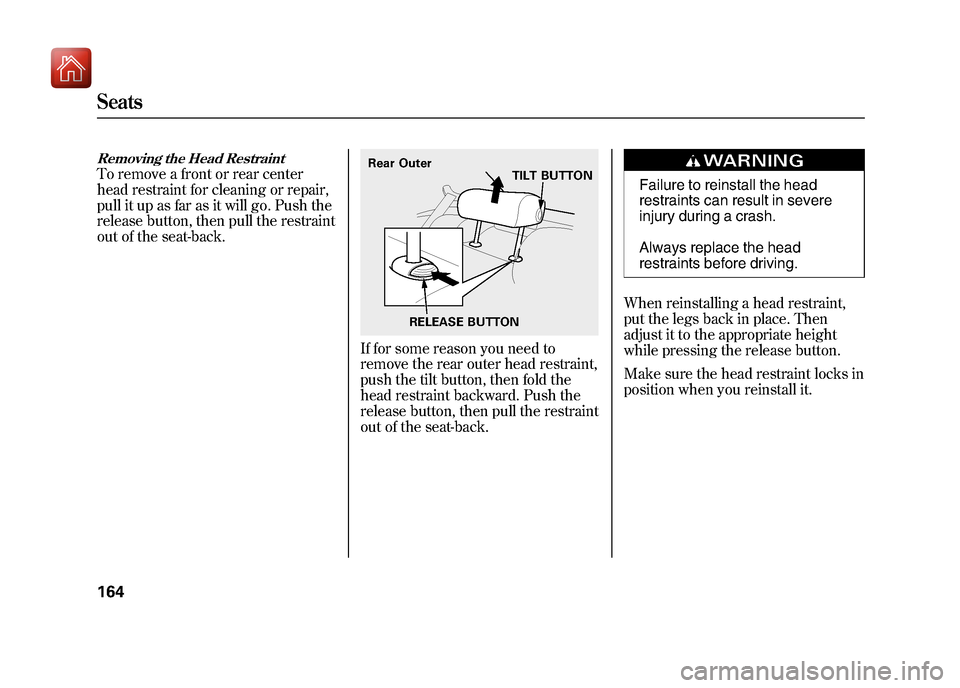
Removing the Head RestraintTo remove a front or rear center
head restraint for cleaning or repair,
pull it up as far as it will go. Push the
release button, then pull the restraint
out of the seat-back.
If for some reason you need to
remove the rear outer head restraint,
push the tilt button, then fold the
head restraint backward. Push the
release button, then pull the restraint
out of the seat-back.
Failure to reinstall the head
restraints can result in severe
injury during a crash.
Always replace the head
restraints before driving.
When reinstalling a head restraint,
put the legs back in place. Then
adjust it to the appropriate height
while pressing the release button.
Make sure the head restraint locks in
position when you reinstall it.
Rear Outer TILT BUTTON
RELEASE BUTTON
Seats16409/10/28 17:15:37 10 ACURA ZDX KA KC New North America Own 50 31SZN600 enu
Page 531 of 645
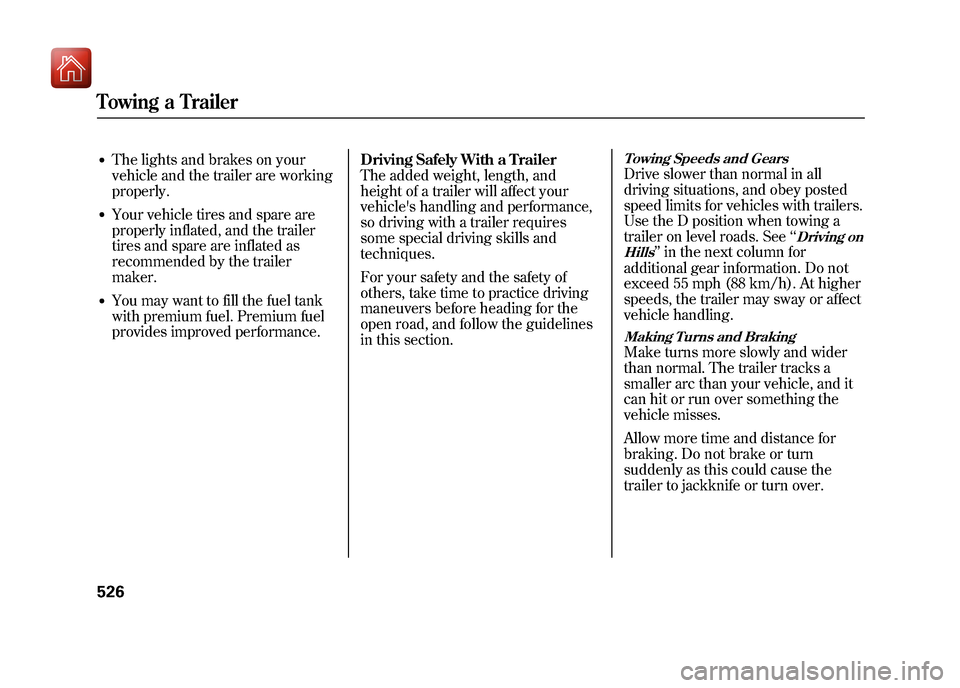
●The lights and brakes on your
vehicle and the trailer are working
properly.●Your vehicle tires and spare are
properly inflated, and the trailer
tires and spare are inflated as
recommended by the trailer
maker.●You may want to fill the fuel tank
with premium fuel. Premium fuel
provides improved performance.Driving Safely With a Trailer
The added weight, length, and
height of a trailer will affect your
vehicle's handling and performance,
so driving with a trailer requires
some special driving skills and
techniques.
For your safety and the safety of
others, take time to practice driving
maneuvers before heading for the
open road, and follow the guidelines
in this section.
Towing Speeds and GearsDrive slower than normal in all
driving situations, and obey posted
speed limits for vehicles with trailers.
Use the D position when towing a
trailer on level roads. See
‘‘
Driving on
Hills
’’ in the next column for
additional gear information. Do not
exceed 55 mph (88 km/h). At higher
speeds, the trailer may sway or affect
vehicle handling.
Making Turns and BrakingMake turns more slowly and wider
than normal. The trailer tracks a
smaller arc than your vehicle, and it
can hit or run over something the
vehicle misses.
Allow more time and distance for
braking. Do not brake or turn
suddenly as this could cause the
trailer to jackknife or turn over.
Towing a Trailer52609/10/28 17:15:37 10 ACURA ZDX KA KC New North America Own 50 31SZN600 enu
Page 613 of 645
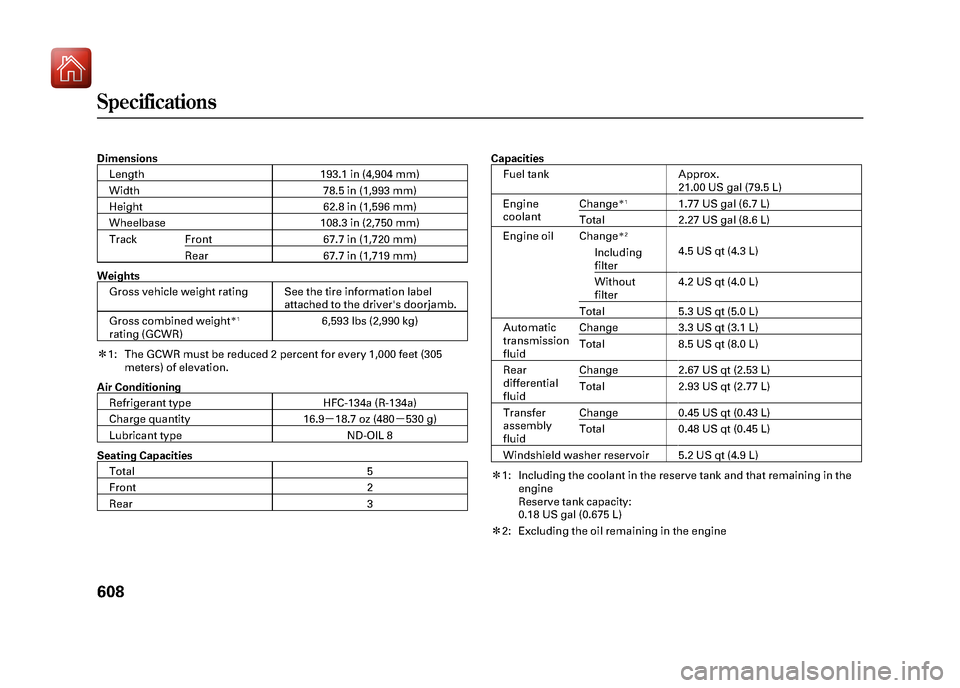
DimensionsLength 193.1 in (4,904 mm)
Width 78.5 in (1,993 mm)
Height 62.8 in (1,596 mm)
Wheelbase 108.3 in (2,750 mm)
Track Front 67.7 in (1,720 mm)
Rear 67.7 in (1,719 mm)
Weights Gross vehicle weight rating See the tire information label attached to the driver's doorjamb.
Gross combined weight
ꭧ 1
rating (GCWR) 6,593 lbs (2,990 kg)
ꭧ 1: The GCWR must be reduced 2 percent for every 1,000 feet (305
meters) of elevation.
Air Conditioning Refrigerant type HFC-134a (R-134a)
Charge quantity 16.9 -18.7 oz (480 -530 g)
Lubricant type ND-OIL 8
Seating Capacities Total 5
Front 2
Rear 3 Capacities
Fuel tank Approx. 21.00 US gal (79.5 L)
Engine
coolant Change
ꭧ
1
1.77 US gal (6.7 L)
Total 2.27 US gal (8.6 L)
Engine oil Change
ꭧ 2
4.5 US qt (4.3 L)
Including
filter
Without
filter 4.2 US qt (4.0 L)
Total 5.3 US qt (5.0 L)
Automatic
transmission
fluid Change 3.3 US qt (3.1 L)
Total 8.5 US qt (8.0 L)
Rear
differential
fluid Change 2.67 US qt (2.53 L)
Total 2.93 US qt (2.77 L)
Transfer
assembly
fluid Change 0.45 US qt (0.43 L)
Total 0.48 US qt (0.45 L)
Windshield washer reservoir 5.2 US qt (4.9 L)
ꭧ 1: Including the coolant in the reserve tank and that remaining in the
engine
Reserve tank capacity:
0.18 US gal (0.675 L)
ꭧ 2: Excluding the oil remaining in the engine
Specifications60809/10/28 17:15:37 10 ACURA ZDX KA KC New North America Own 50 31SZN600 enu
Page 617 of 645

The tires that came on your vehicle
have a number of markings. Those
you should be aware of are described
below.
Tire SizeWhenever tires are replaced, they
should be replaced with tires of the
same size. The following is an
example of tire size with an
explanation of what each component
means.P255/50R19 103H
P -Vehicle type (P indicates
passenger vehicle).
255 -Tire width in millimeters.
50 -Aspect ratio (the tire's
section height as a
percentage of its width).
R -Tire construction code (R
indicates radial).
19 -Rim diameter in inches. 103
-Load index (a numerical code
associated with the
maximum load the tire can
carry).
H -Speed symbol (an
alphabetical code indicating
the maximum speed rating).
Tire Identification Number (TIN)The tire identification number (TIN)
is a group of numbers and letters that
look like the following example. TIN
is located on the sidewall of the tire.
DOT B97R FW6X 2202
DOT -This indicates that the tire
meets all requirements of
the U.S. Department of
Transportation.
B97R -Manufacturer's
identification mark.
TIRE LABELING EXAMPLE
(1) Tire Size
(2) Tire Identification Number (TIN)
(3) Maximum Tire Pressure
(4) Maximum Tire Load (4)
(3) (2)(1)
(1)Tire Labeling61209/10/28 17:15:37 10 ACURA ZDX KA KC New North America Own 50 31SZN600 enu